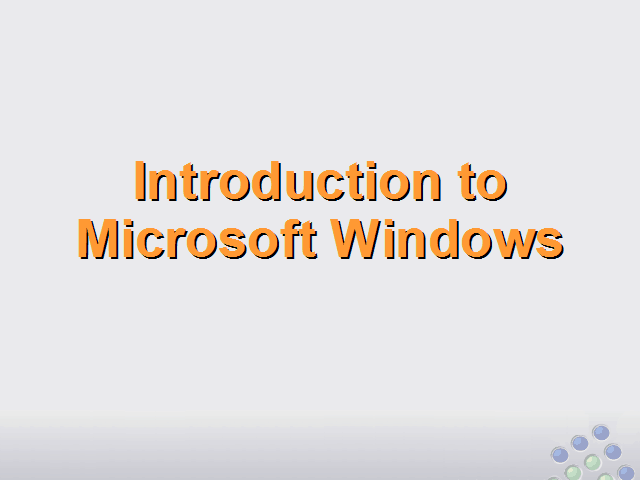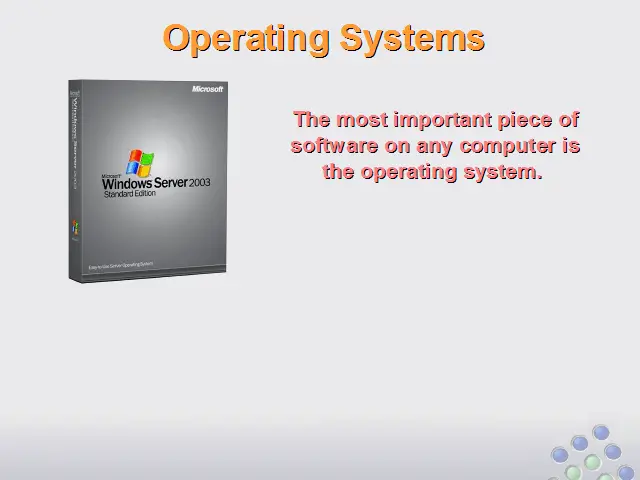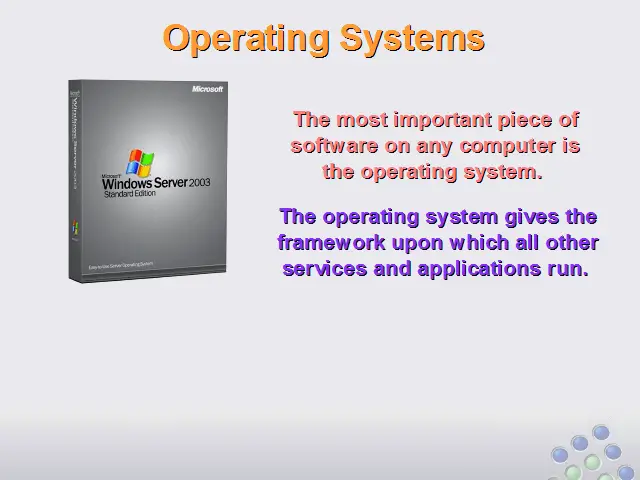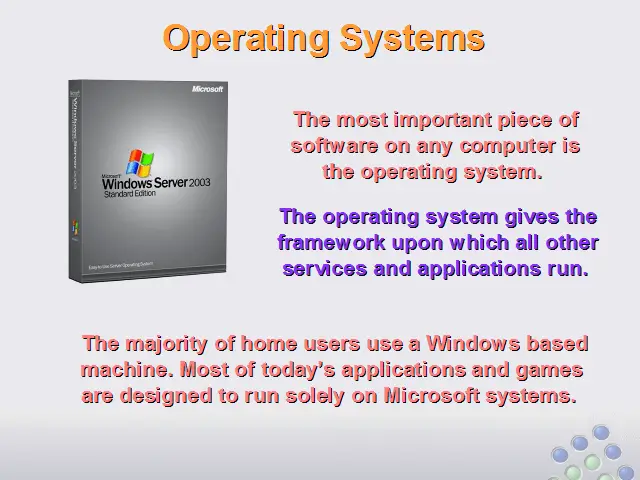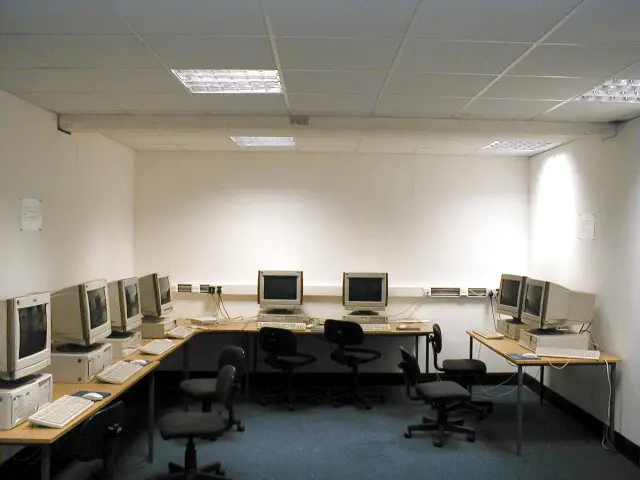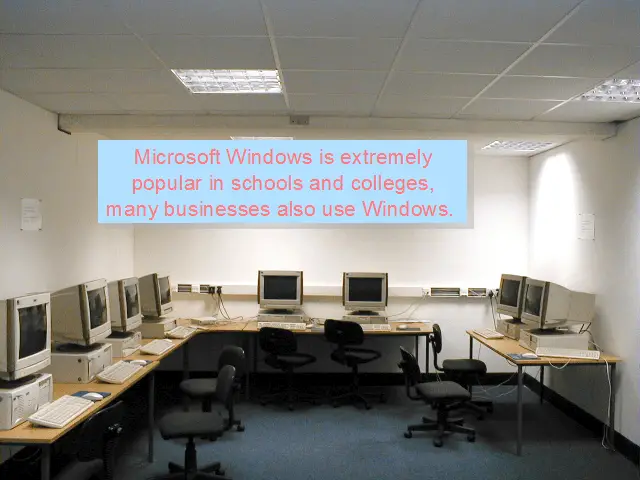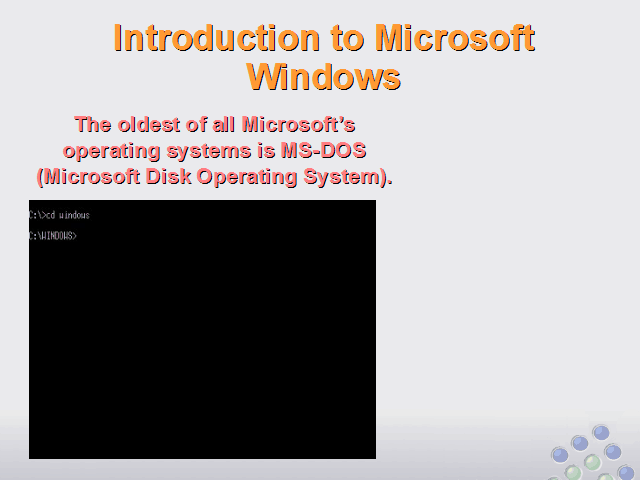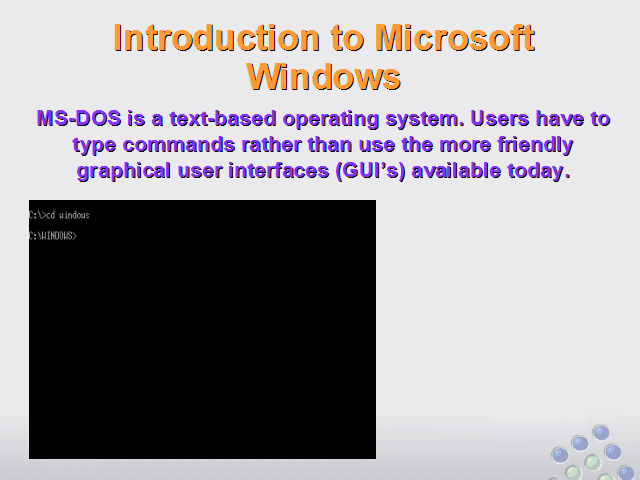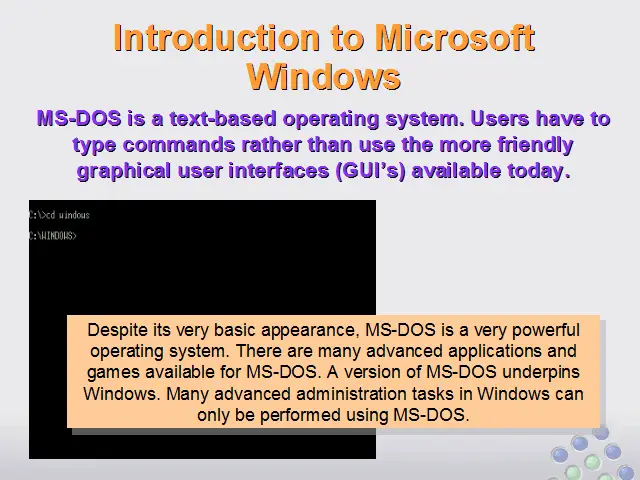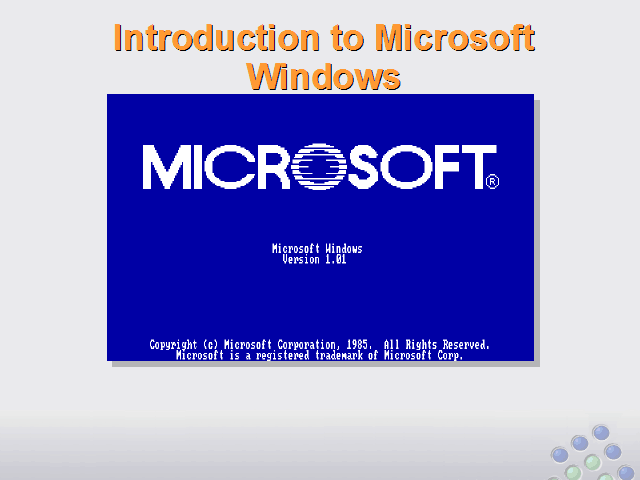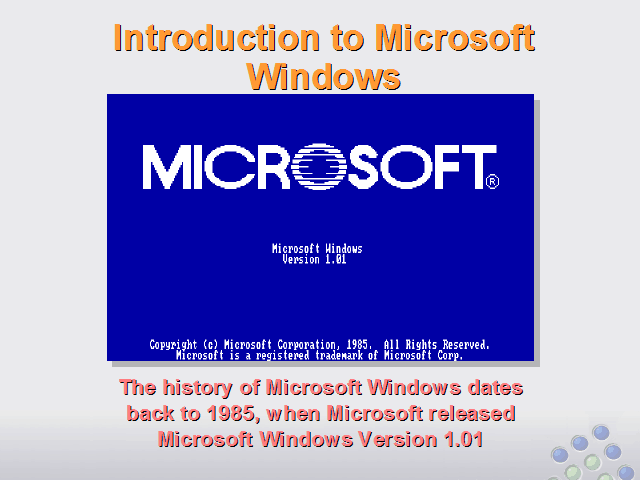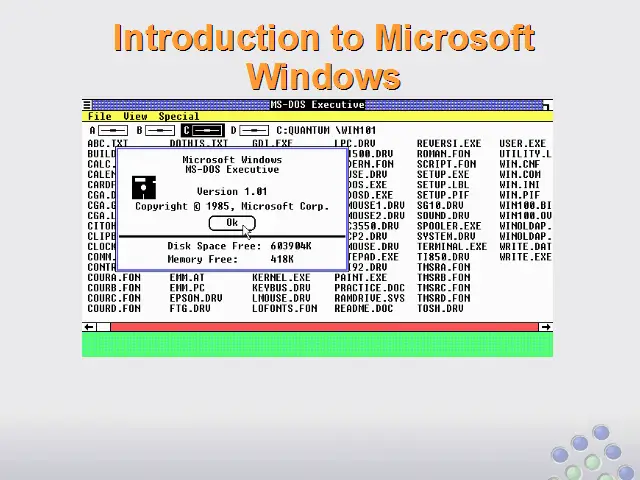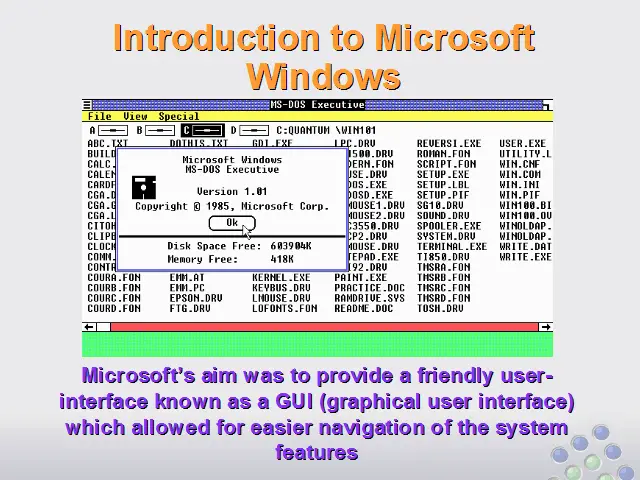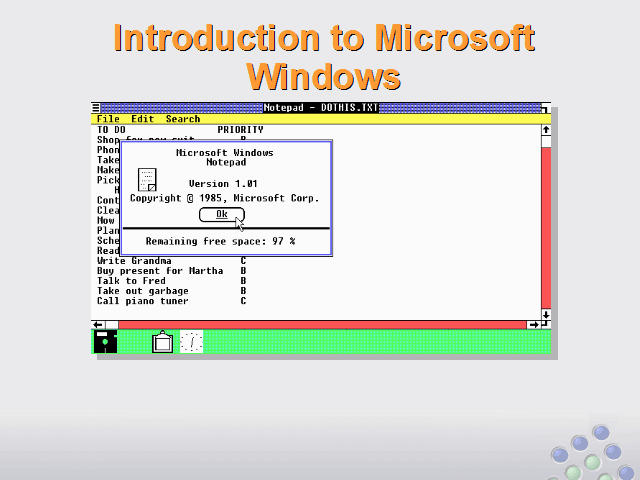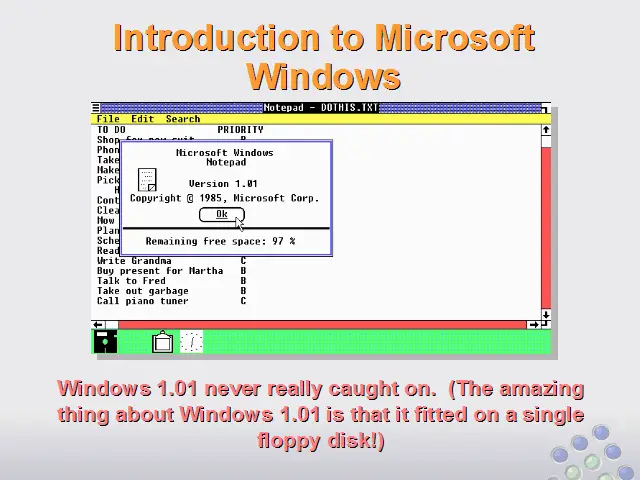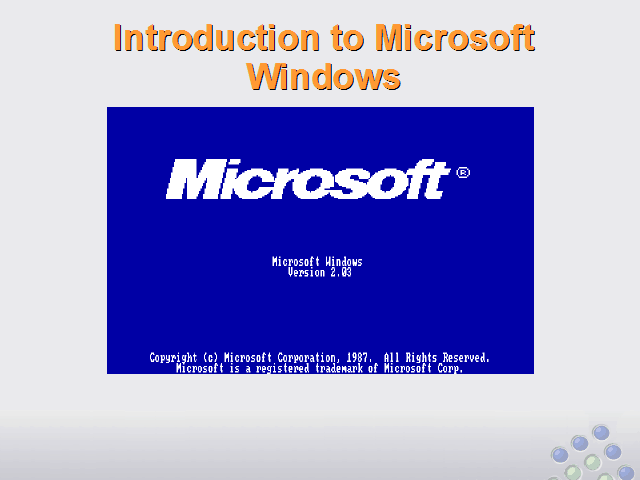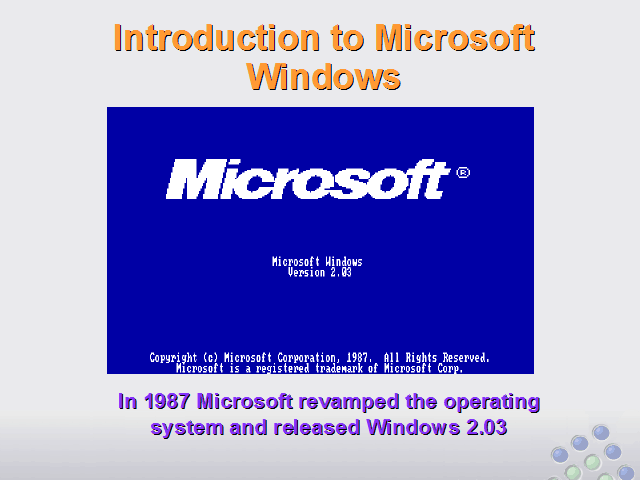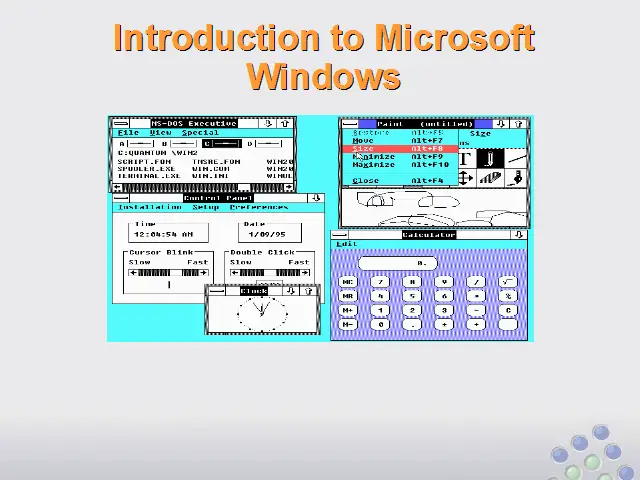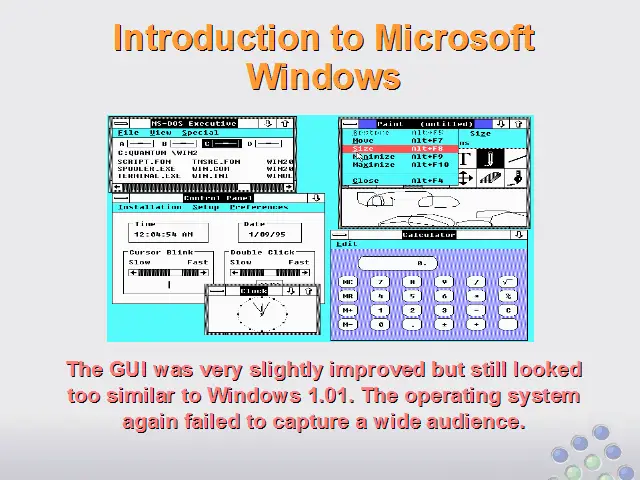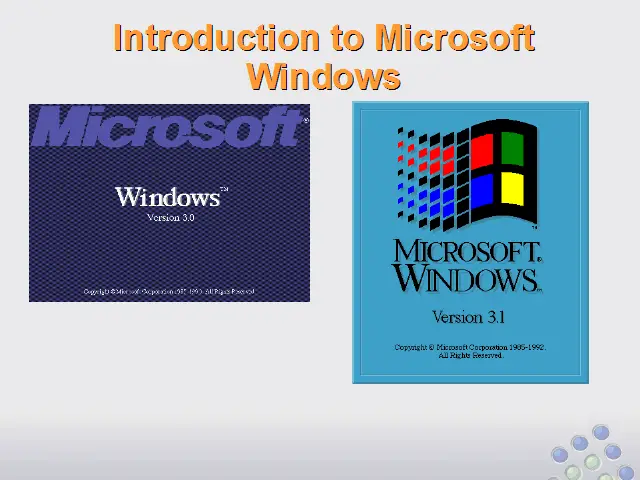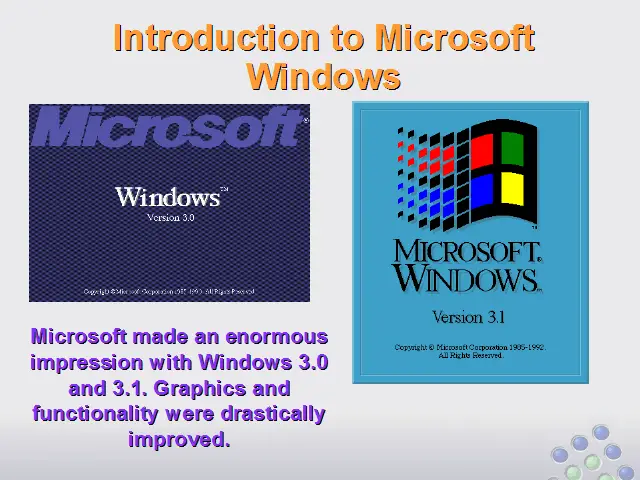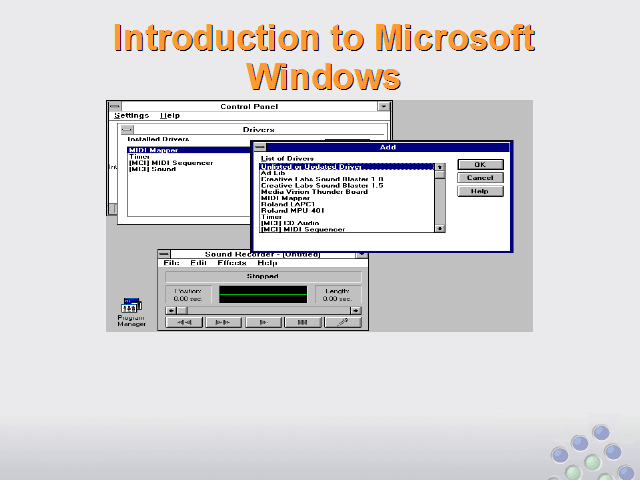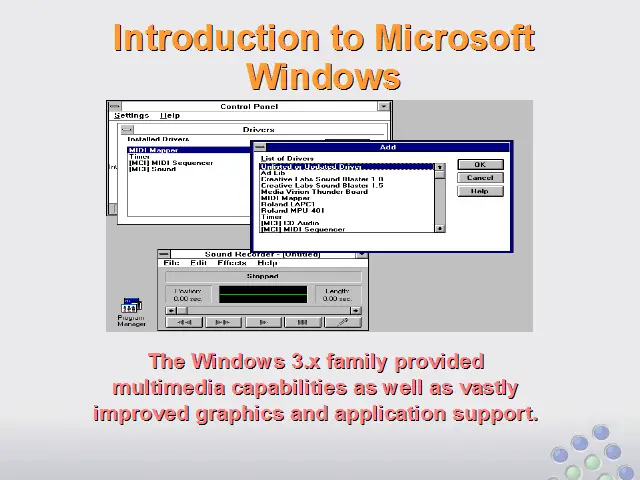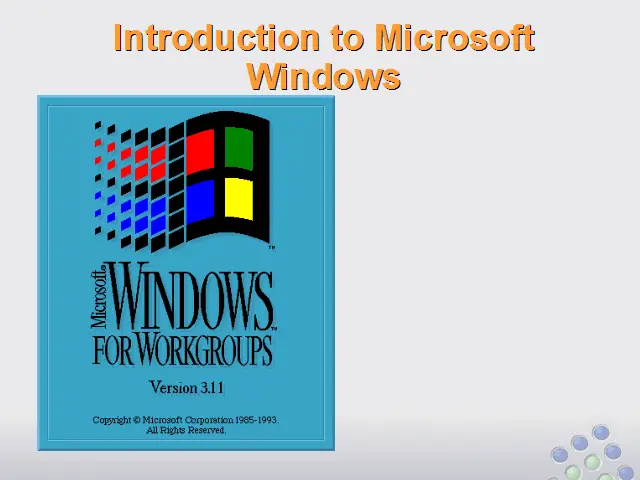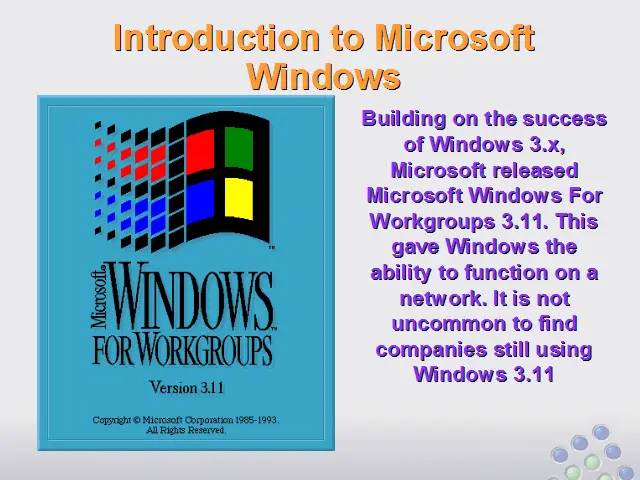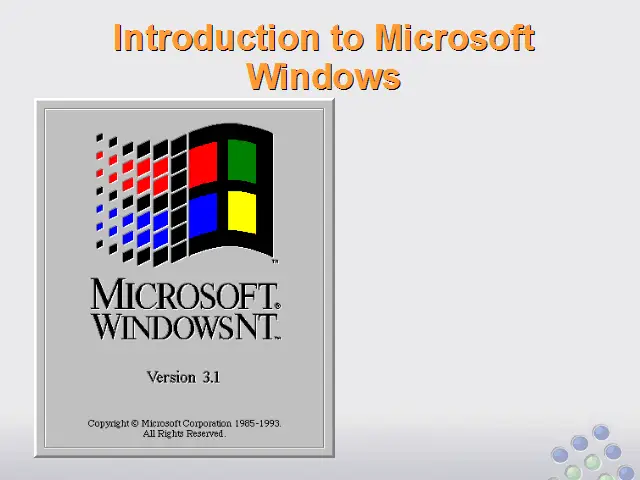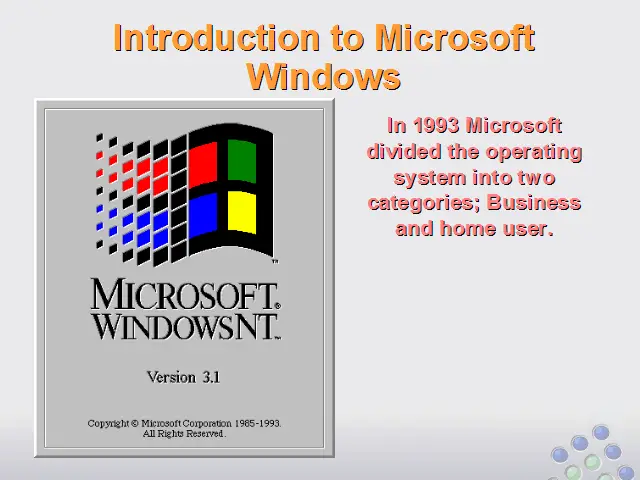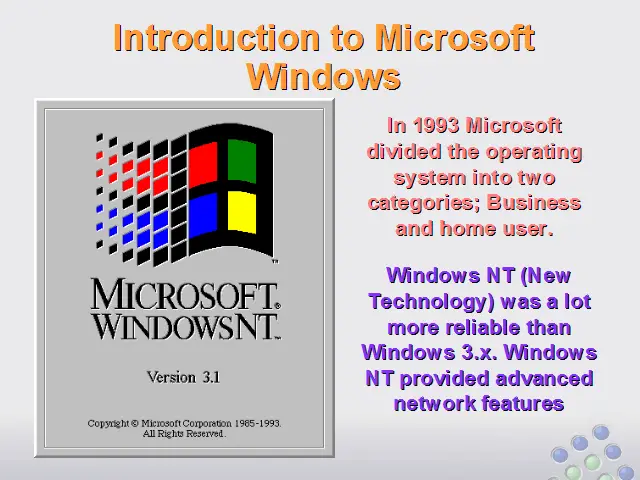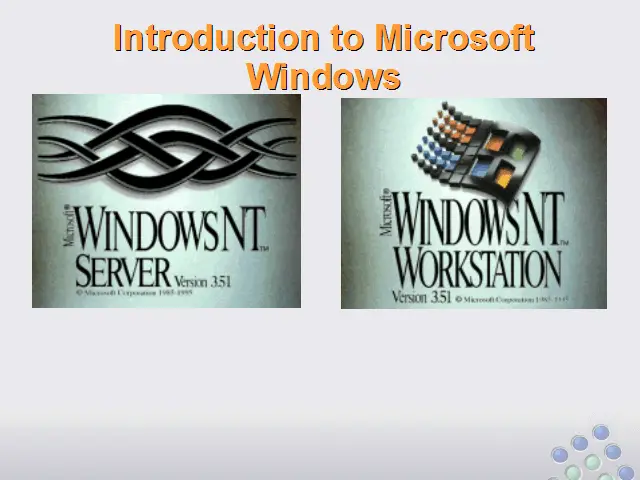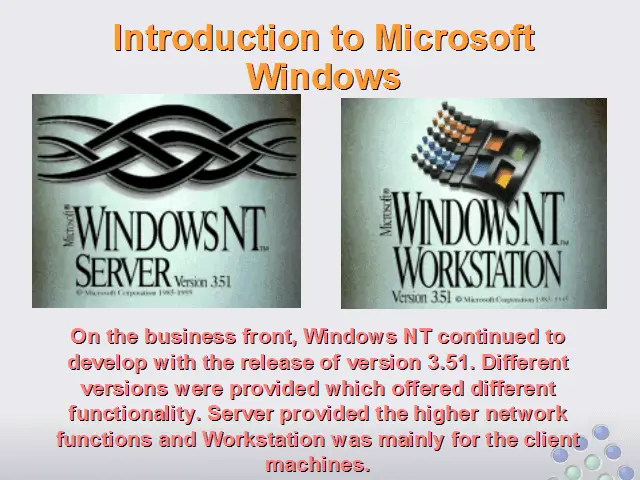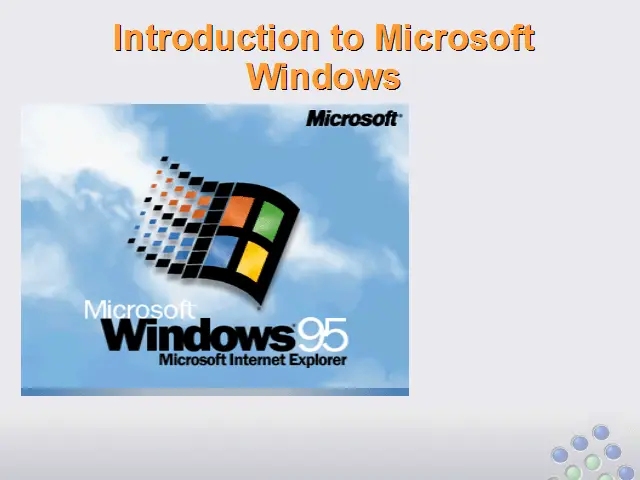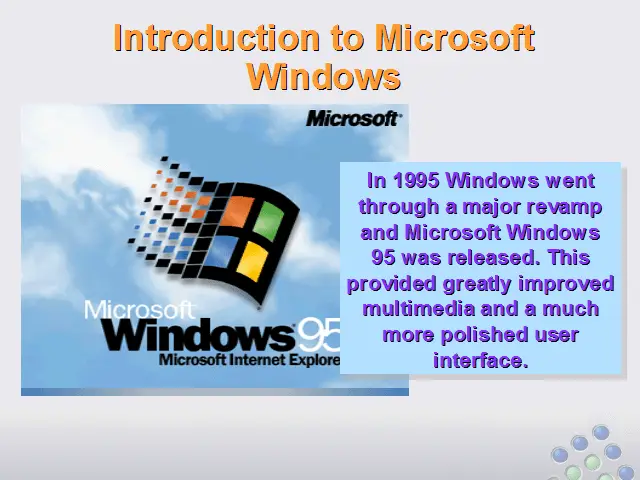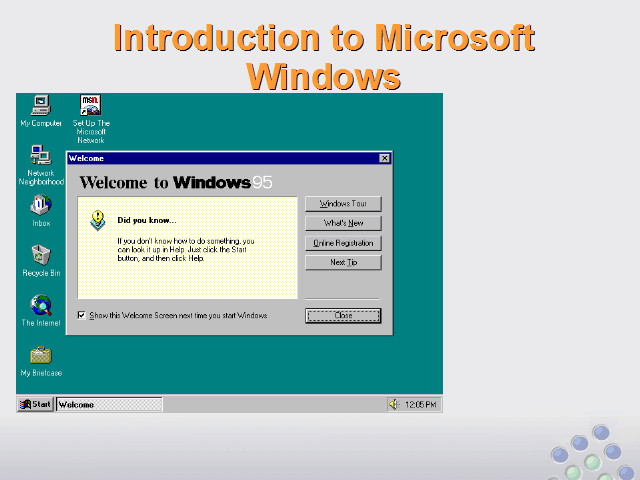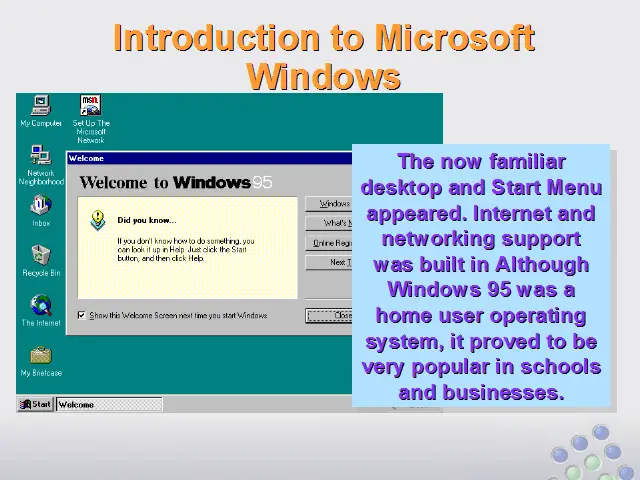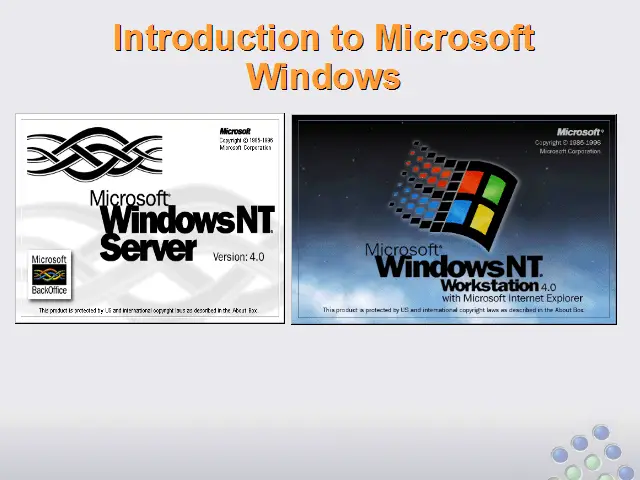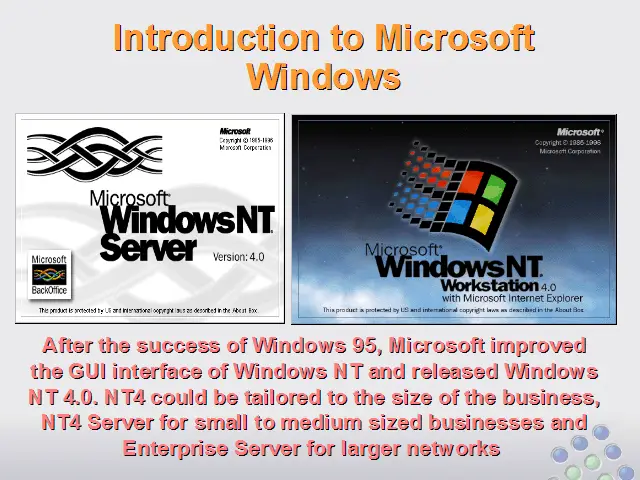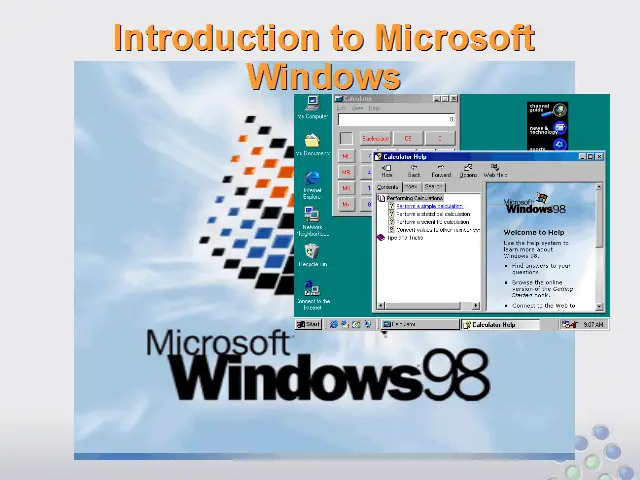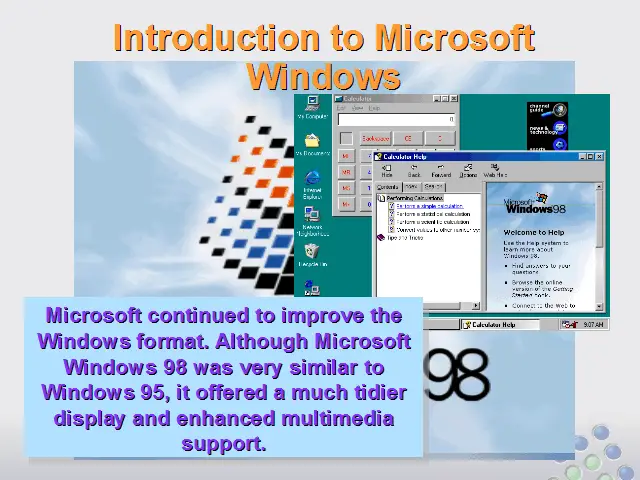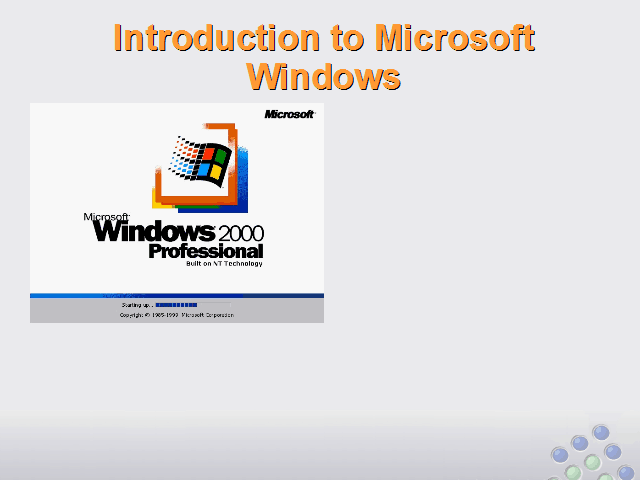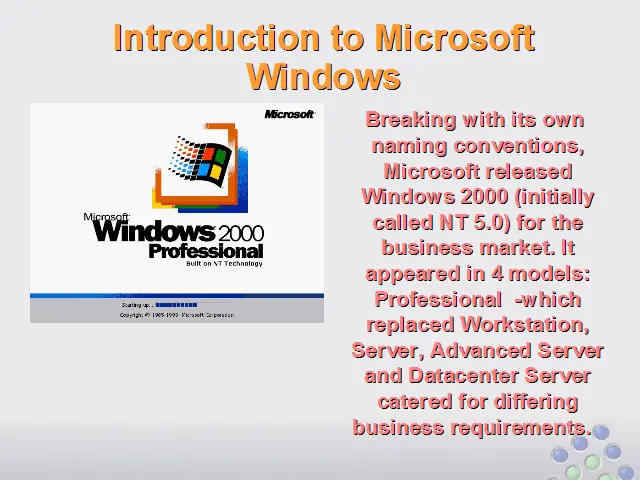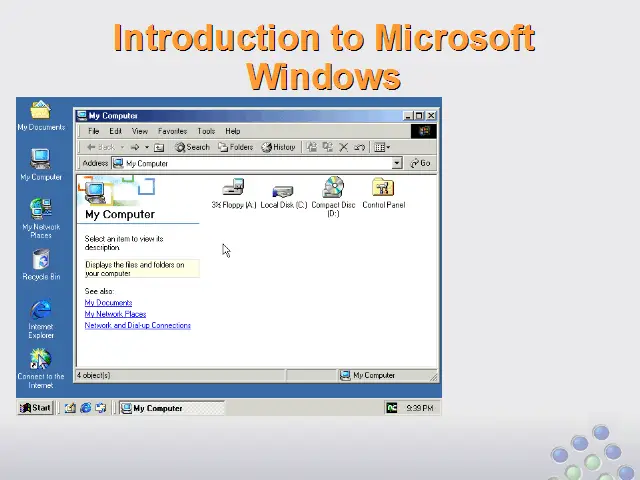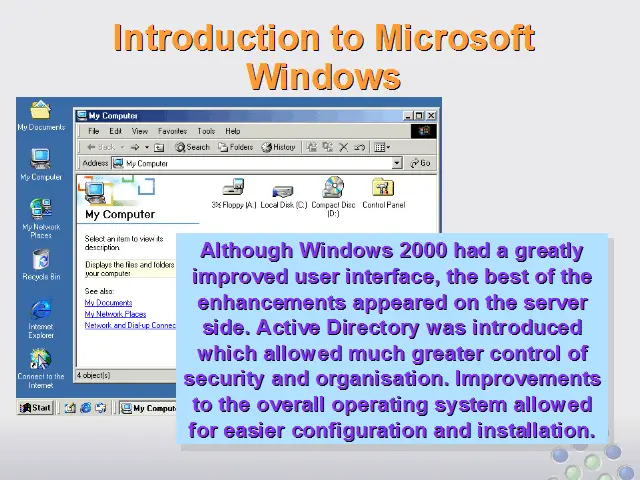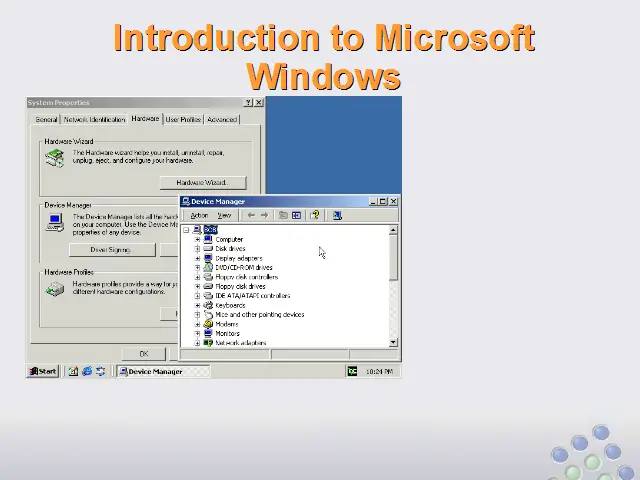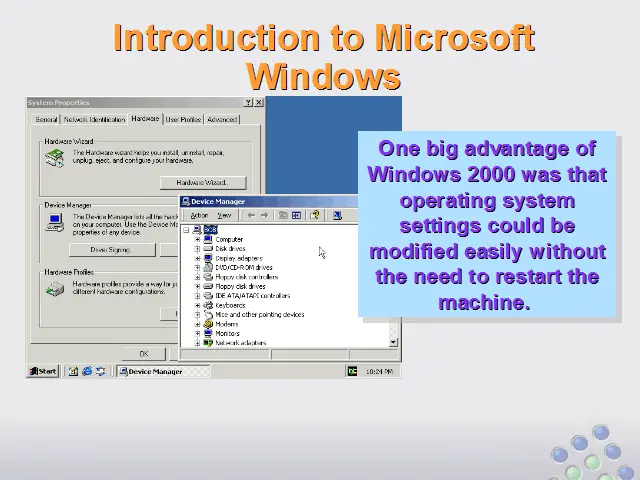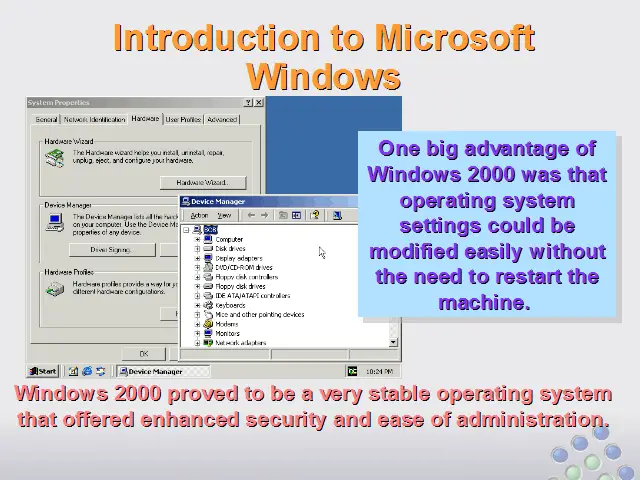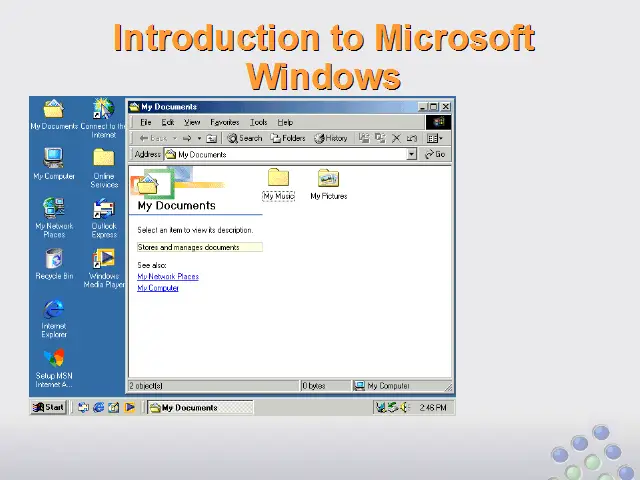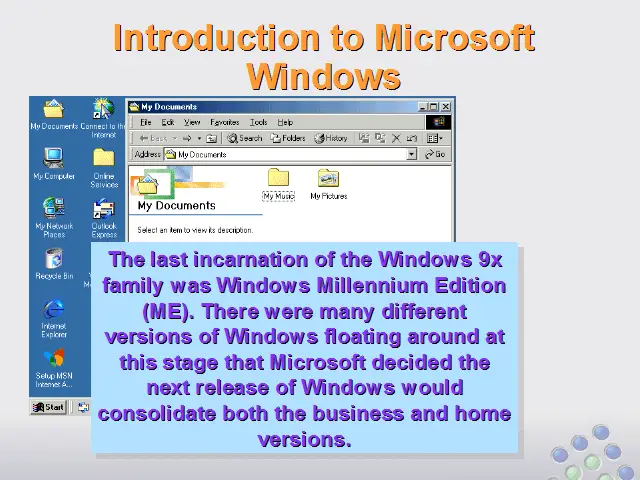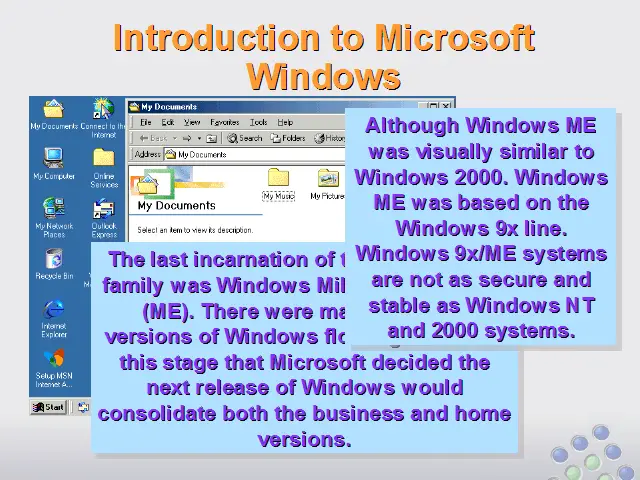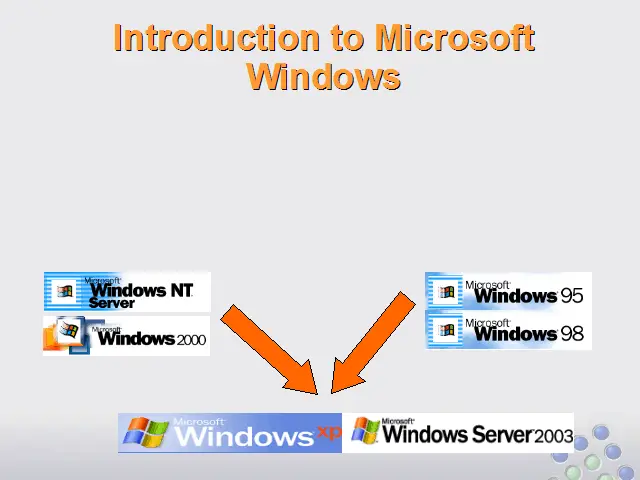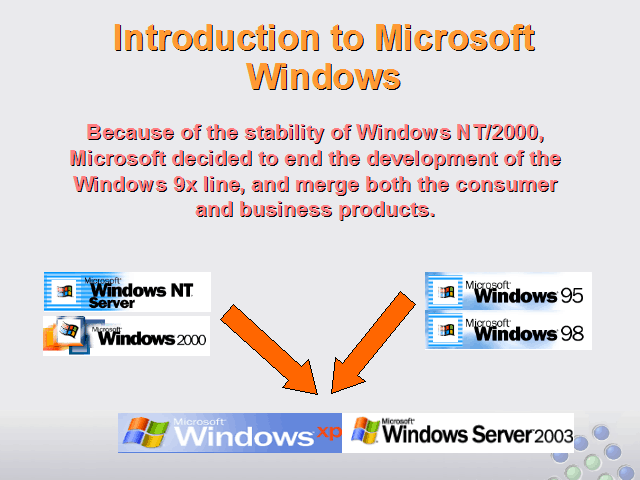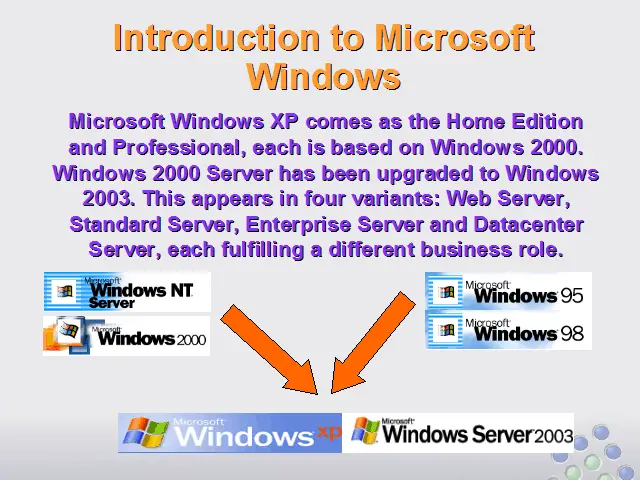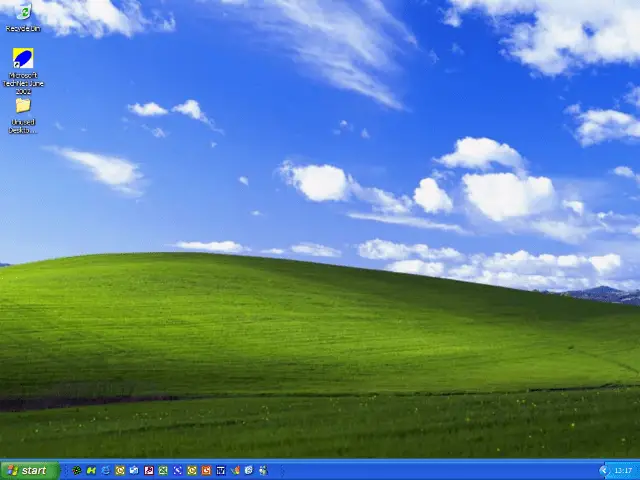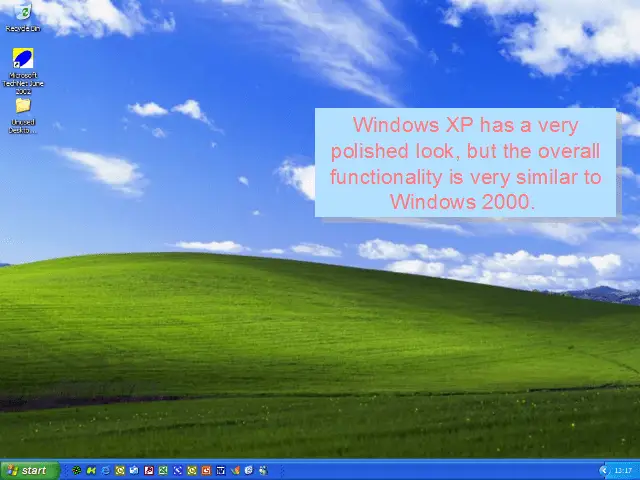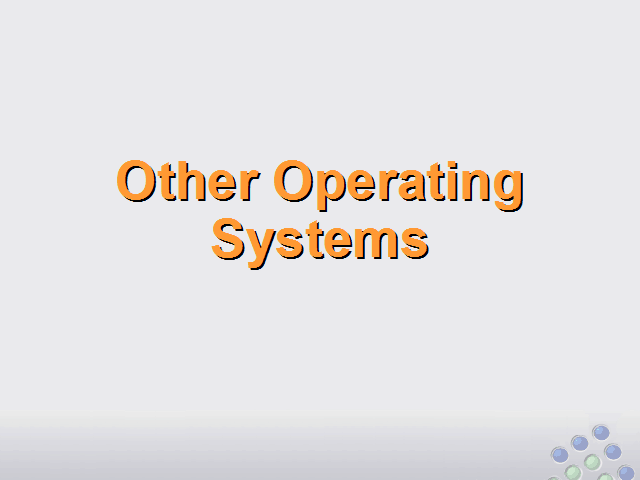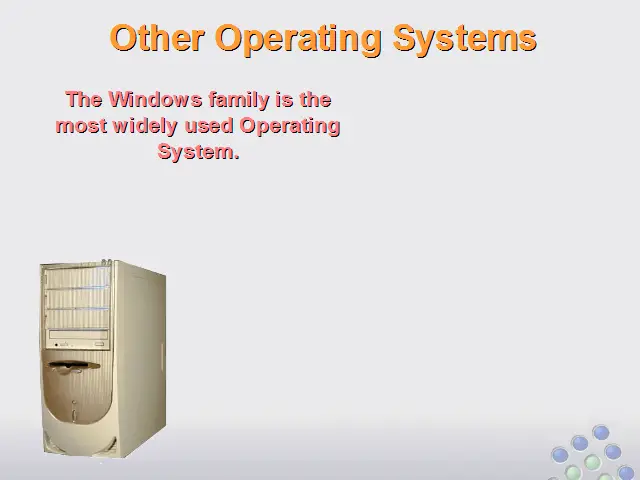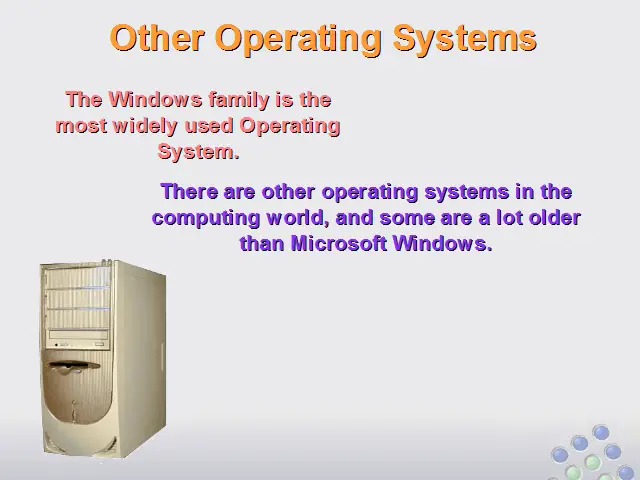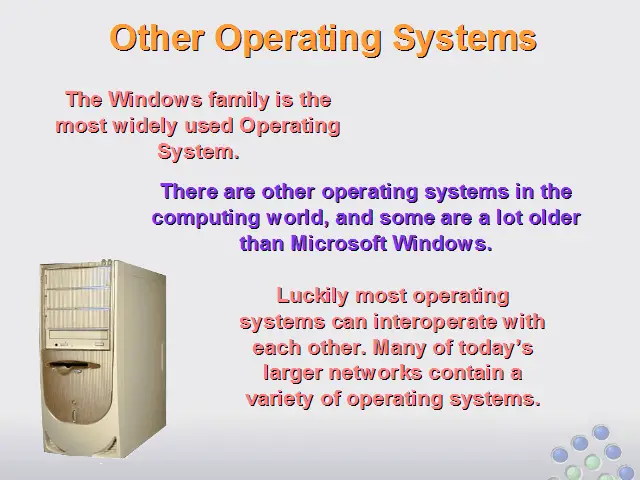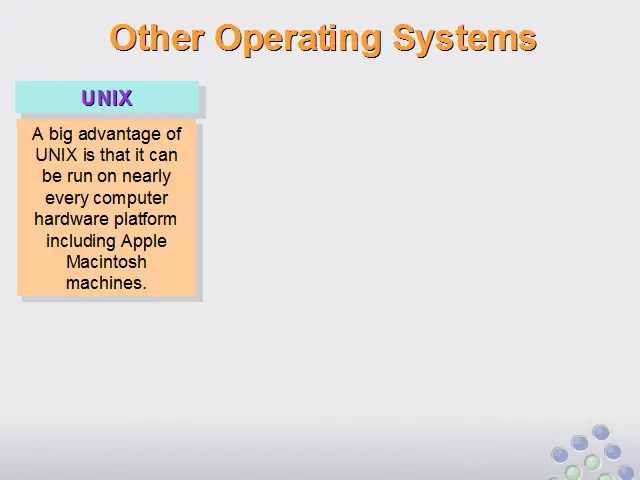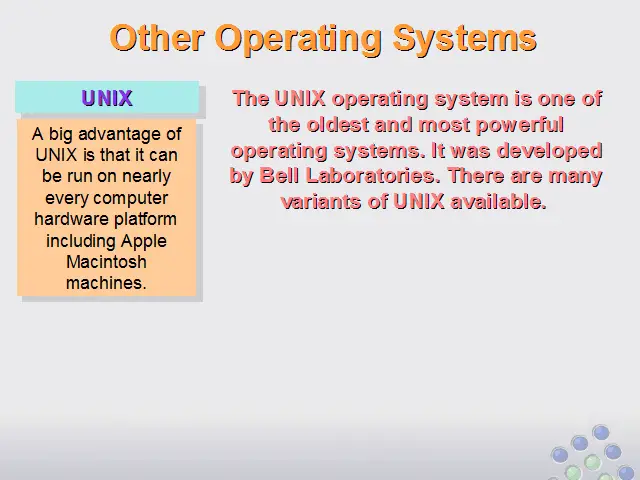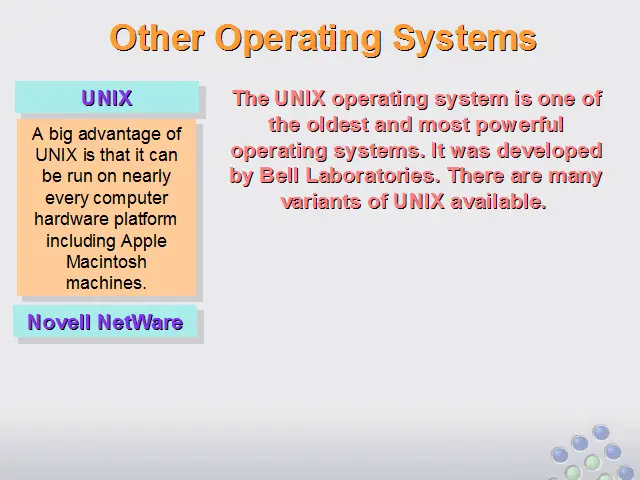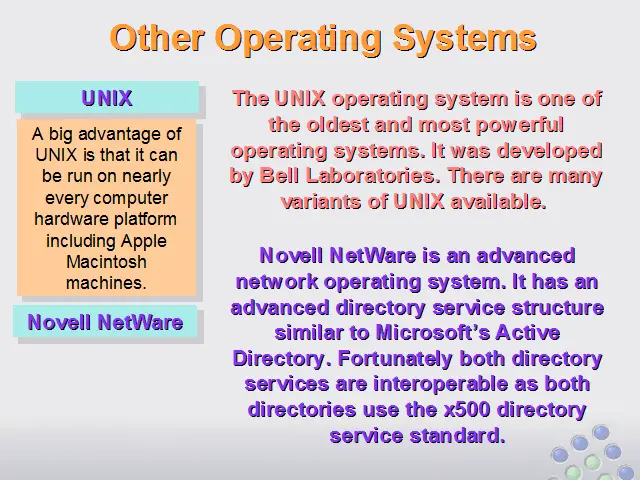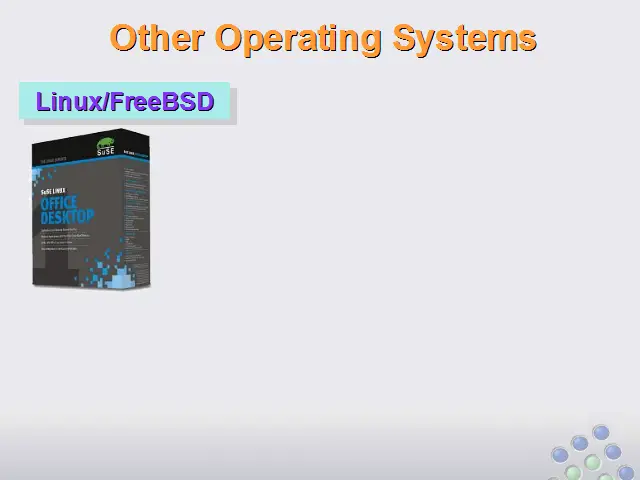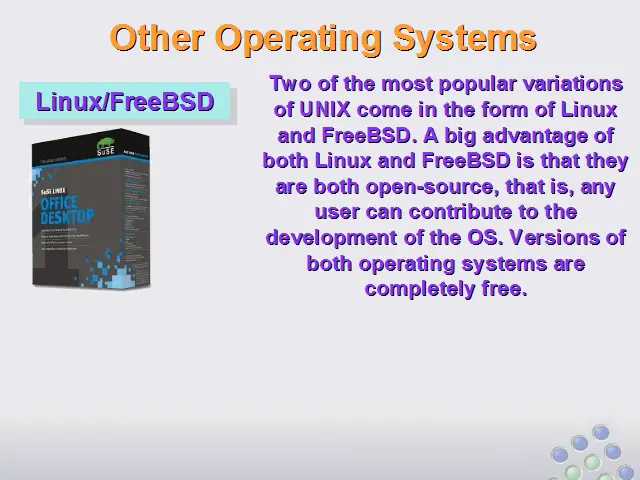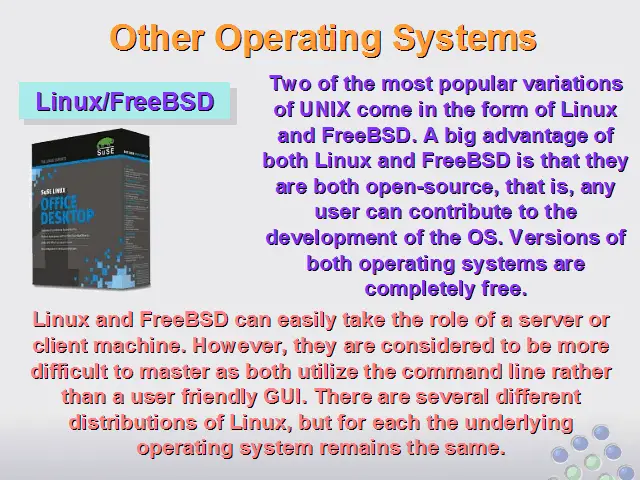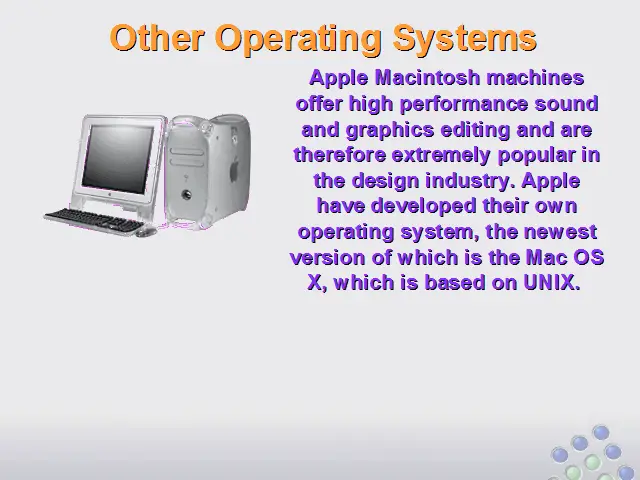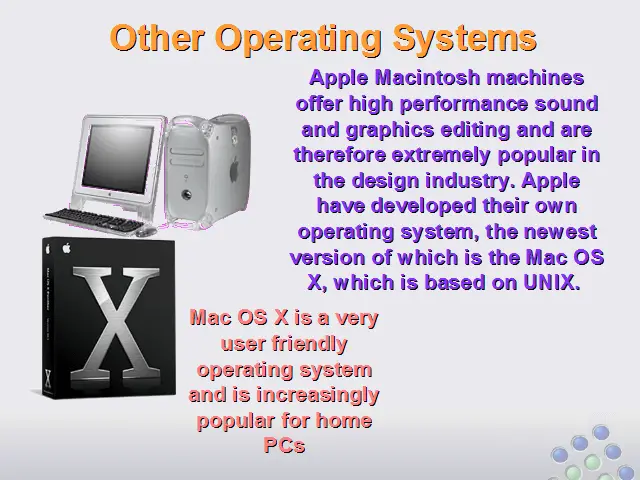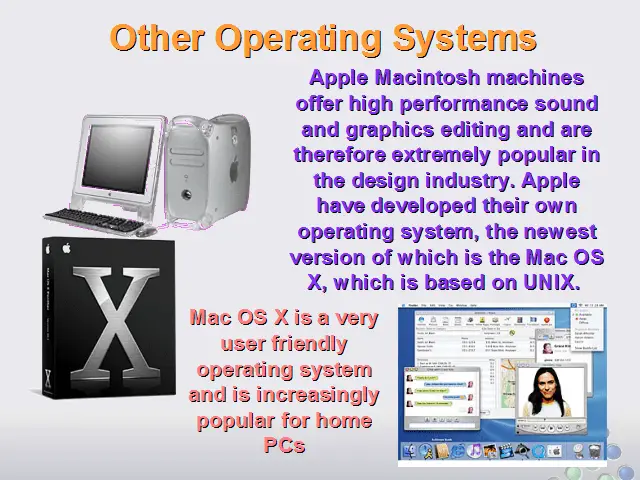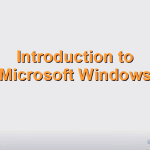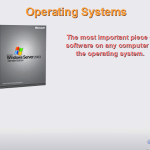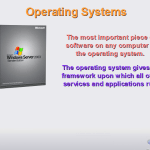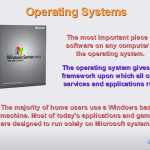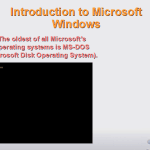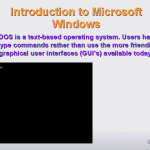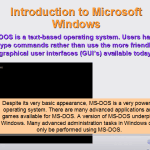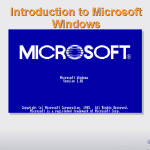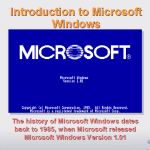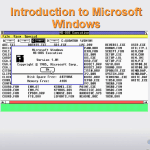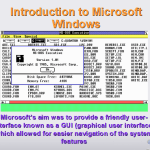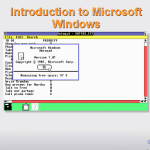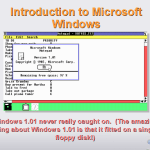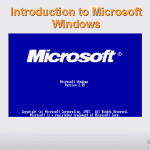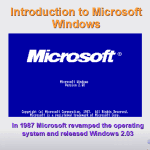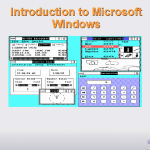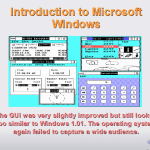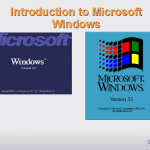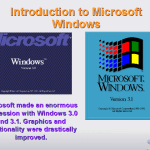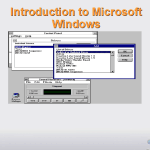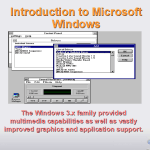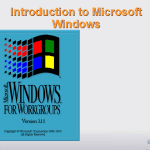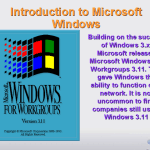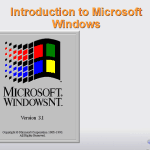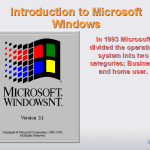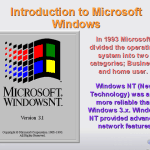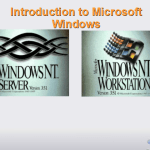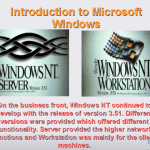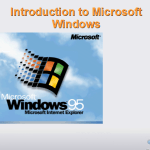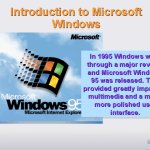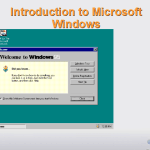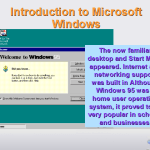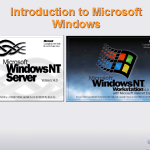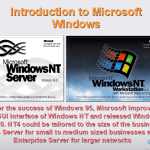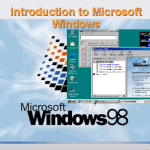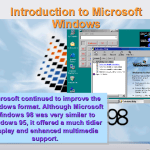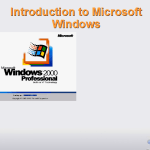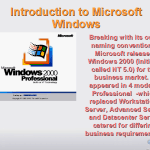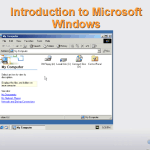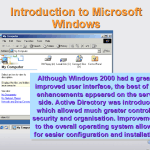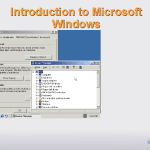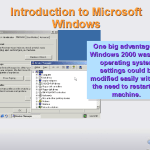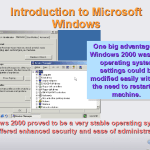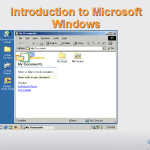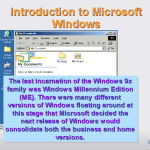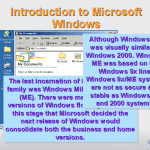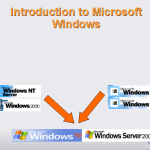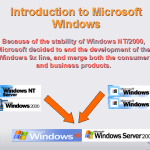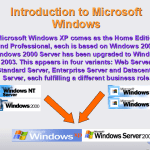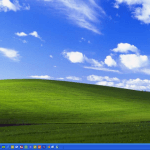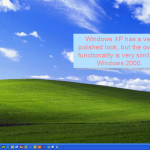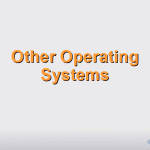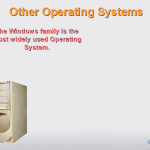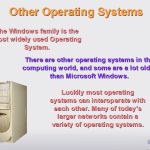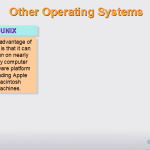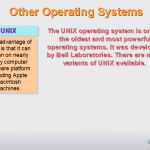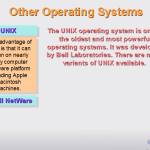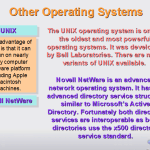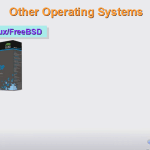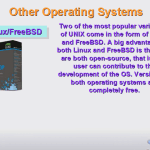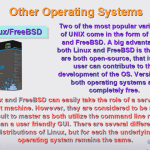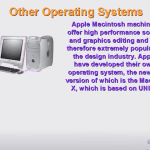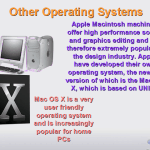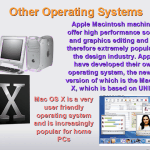Introduction To Windows
Operating Systems
The most important piece of software on any computer is the operating system. The operating system gives the framework upon which all other services and applications run. The majority of home users use a Windows based machine. Most of today’s applications and games are designed to run solely on Microsoft systems.
Microsoft Windows is extremely popular in schools and colleges, many businesses also use Windows.
Use the buttons below to navigate through the lesson
Introduction to Microsoft Windows
The oldest of all Microsoft’s operating systems is MS-DOS (Microsoft Disk Operating System). MS-DOS is a text-based operating system. Users have to type commands rather than use the more friendly graphical user interfaces (GUI’s) available today. Despite its very basic appearance, MS-DOS is a very powerful operating system. There are many advanced applications and games available for MS-DOS. A version of MS-DOS underpins Windows. Many advanced administration tasks in Windows can only be performed using MS-DOS.
 The history of Microsoft Windows dates back to 1985, when Microsoft released Microsoft Windows Version 1.01. Microsoft’s aim was to provide a friendly user-interface known as a GUI (graphical user interface) which allowed for easier navigation of the system features. Windows 1.01 never really caught on. (The amazing thing about Windows 1.01 is that it fitted on a single floppy disk!). In 1987 Microsoft revamped the operating system and released Windows 2.03. The GUI was very slightly improved but still looked too similar to Windows 1.01. The operating system again failed to capture a wide audience.
The history of Microsoft Windows dates back to 1985, when Microsoft released Microsoft Windows Version 1.01. Microsoft’s aim was to provide a friendly user-interface known as a GUI (graphical user interface) which allowed for easier navigation of the system features. Windows 1.01 never really caught on. (The amazing thing about Windows 1.01 is that it fitted on a single floppy disk!). In 1987 Microsoft revamped the operating system and released Windows 2.03. The GUI was very slightly improved but still looked too similar to Windows 1.01. The operating system again failed to capture a wide audience.
Microsoft made an enormous impression with Windows 3.0 and 3.1. Graphics and functionality were drastically improved. The Windows 3.x family provided multimedia capabilities as well as vastly improved graphics and application support.
Building on the success of Windows 3.x, Microsoft released Microsoft Windows For Workgroups 3.11. This gave Windows the ability to function on a network. It is not uncommon to find companies still using Windows 3.11.
In 1993 Microsoft divided the operating system into two categories; Business and home user. Windows NT (New Technology) was a lot more reliable than Windows 3.x. Windows NT provided advanced network features. On the business front, Windows NT continued to develop with the release of version 3.51. Different versions were provided which offered different functionality. Server provided the higher network functions and Workstation was mainly for the client machines.
In 1995 Windows went through a major revamp and Microsoft Windows 95 was released. This provided greatly improved multimedia and a much more polished user interface. The now familiar desktop and Start Menu appeared. Internet and networking support was built in Although Windows 95 was a home user operating system, it proved to be very popular in schools and businesses.
After the success of Windows 95, Microsoft improved the GUI interface of Windows NT and released Windows NT 4.0. NT4 could be tailored to the size of the business, NT4 Server for small to medium sized businesses and Enterprise Server for larger networks. Microsoft continued to improve the Windows format. Although Microsoft Windows 98 was very similar to Windows 95, it offered a much tidier display and enhanced multimedia support.
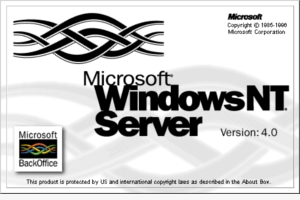 Breaking with its own naming conventions, Microsoft released Windows 2000 (initially called NT 5.0) for the business market. It appeared in 4 models: Professional -which replaced Workstation, Server, Advanced Server and Datacenter Server catered for differing business requirements.
Breaking with its own naming conventions, Microsoft released Windows 2000 (initially called NT 5.0) for the business market. It appeared in 4 models: Professional -which replaced Workstation, Server, Advanced Server and Datacenter Server catered for differing business requirements.
Although Windows 2000 had a greatly improved user interface, the best of the enhancements appeared on the server side. Active Directory was introduced which allowed much greater control of security and organisation. Improvements to the overall operating system allowed for easier configuration and installation.
One big advantage of Windows 2000 was that operating system settings could be modified easily without the need to restart the machine. Windows 2000 proved to be a very stable operating system that offered enhanced security and ease of administration.
The last incarnation of the Windows 9x family was Windows Millennium Edition (ME). There were many different versions of Windows floating around at this stage that Microsoft decided the next release of Windows would consolidate both the business and home versions. Although Windows ME was visually similar to Windows 2000. Windows ME was based on the Windows 9x line. Windows 9x/ME systems are not as secure and stable as Windows NT and 2000 systems.
Because of the stability of Windows NT/2000, Microsoft decided to end the development of the Windows 9x line, and merge both the consumer and business products. Microsoft Windows XP comes as the Home Edition and Professional, each is based on Windows 2000. Windows 2000 Server has been upgraded to Windows 2003. This appears in four variants: Web Server, Standard Server, Enterprise Server and Datacenter Server, each fulfilling a different business role. Windows XP has a very polished look, but the overall functionality is very similar to Windows 2000.
Other Operating Systems
The Windows family is the most widely used Operating System. There are other operating systems in the computing world, and some are a lot older than Microsoft Windows. Luckily most operating systems can interoperate with each other. Many of today’s larger networks contain a variety of operating systems.
UNIX
A big advantage of UNIX is that it can be run on nearly every computer hardware platform including Apple Macintosh machines. The UNIX operating system is one of the oldest and most powerful operating systems. It was developed by Bell Laboratories. There are many variants of UNIX available.
Novell NetWare
Novell NetWare is an advanced network operating system. It has an advanced directory service structure similar to Microsoft’s Active Directory. Fortunately both directory services are interoperable as both directories use the x500 directory service standard.
Linux/FreeBSD
Two of the most popular variations of UNIX come in the form of Linux and FreeBSD. A big advantage of both Linux and FreeBSD is that they are both open-source, that is, any user can contribute to the development of the OS. Versions of both operating systems are completely free.
Linux and FreeBSD can easily take the role of a server or client machine. However, they are considered to be more difficult to master as both utilize the command line rather than a user friendly GUI. There are several different distributions of Linux, but for each the underlying operating system remains the same.
Apple Macintosh machines offer high performance sound and graphics editing and are therefore extremely popular in the design industry. Apple have developed their own operating system, the newest version of which is the Mac OS X, which is based on UNIX.
Mac OS X is a very user friendly operating system and is increasingly popular for home PCs.
